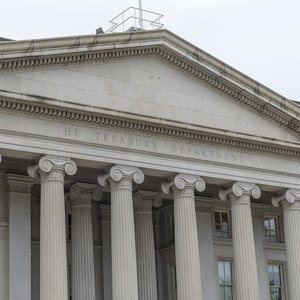
The 10-year U.S. Treasury note is a benchmark for the broader economy. When interest rates on the 10-year move up or down, it has an impact on other economic factors, from yields on other instruments to the performance of the stock market. As such, the yield on the 10-year note is widely followed.
Tips
The 10-year treasury yield is widely considered to be one of the safest investment vehicles in the world due to their backing by the U.S. government. Price action on the 1o-year treasury yield is commonly linked to movement on the 30-year mortgage index.
What Is the 10-Year Treasury?
On the face of it, the 10-year Treasury note is not a complex instrument. It's simply a debt obligation issued by the U.S. government that pays interest every six months and principal at maturity. The 10-year Treasury is just one of many such securities offered by the U.S. government, ranging in terms from 4 weeks to 30 years. U.S. Treasury securities are considered among the safest investments in the world, as their principal and interest payments are backed by the full faith and credit of the U.S. government. Additionally, interest paid on Treasuries is local and state tax-free.
Importance of 10-Year Yield
The 10-year yield matters to investors who buy the bond because when yields are higher, they earn a better return. However, the 10-year yield is also used as a proxy rate for other market rates, particularly mortgage rates. Over the long run, the 30-year fixed mortgage rate in the U.S. moves almost in lockstep with movements in the 10-year Treasury yield. So when 10-year rates are ticking higher, you can assume that 30-year fixed mortgage rates will follow suit.
Factors Affecting 10-Year Yield
When investors are fearful, they tend to buy conservative investments. Thus when there is widespread buying of the 10-year Treasury, it can reflect general nervousness in the marketplace. This is reflected in the yield of the 10-year Treasury.
An influx of buyers of the 10-year Treasury will drive up the price of the bonds. This is a simple matter of supply and demand. Just like in the stock market, if there are more buyers than sellers, the price of a security will rise.
In the bond world, prices are inversely correlated with yields. This means that when prices go up, bond yields go down. The opposite is also true. When there are more sellers than buyers, the price of the 10-year Treasury will go down and the yield will go up. This can happen if investors anticipate rising inflation; in this type of environment, the Federal Open Market Committee, known as the Fed, tends to raise interest rates.
Long-Term Trend
The 10-year Treasury rate doesn't generally fluctuate a great deal over the short term. However, over time, the 10-year rate can make major moves, typically as a reflection of the inflationary state of the economy. For example, in 1980 and 1981, U.S. inflation ran in the double digits. The 10-year Treasury rate spiked as well, hitting 15.84 percent. The rate then went on a long-term decline until mid-2016, bottoming out at 1.46 percent. As of mid-2018, the rate hovered around 3 percent.
References
- Daily Treasury Yield Curve Rates
- Federal Reserve Bank of St. Louis: How Might Increases in the Fed Funds Rate Impact Other Interest Rates?
- Multpl.com: US Inflation Rate by Year
- Federal Reserve Bank of St. Louis: 10-Year Treasury Constant Maturity Rate
- Interpretation: Article IV, Section 1: Full Faith and Credit Clause | The National Constitution Center
- Library of Congress. "ArtIV.S1.1.1.1 Full Faith and Credit Clause: Historical Background." Accessed Sept. 8, 2020.
- TreasuryDirect. “Treasury Notes: FAQs.” Accessed Jan. 26, 2020.
- Congressional Research Service. “How Treasury Issues Debt,” Pages 3-8. Accessed Jan. 26, 2020.
- TreasuryDirect. “Auctions In Depth.” Accessed Jan. 26, 2020.
- Corporate Finance Institute. ”10-Year US Treasury Note.” Accessed Jan. 26, 2020.
- TreasuryDirect. “Treasury Notes: Rates & Terms.” Accessed Jan. 26, 2020.
- NAIC. “Interest Rate Impact on Fair Value of U.S. Insurer Investments.” Accessed Jan. 26, 2020.
- FedPrimeRate.com. “Chart: U.S. Prime Rate vs 15- and 30-Year Fixed-Rate Mortgages vs 10-Year Treasury Note.” Accessed Jan. 26, 2020.
- FRED. “Federal Debt: Total Public Debt as Percent of Gross Domestic Product.” Accessed Jan. 26, 2020.
- The World Bank. “Finding the Tipping Point — When Sovereign Debt Turns Bad.” Accessed Jan. 26, 2020.
- Congressional Research Service. “How Treasury Issues Debt,” Pages 12-15. Accessed Jan. 26, 2020.
- Reuters. "Treasuries -- Weak Jobs Data Knock U.S. Yields Lower," Accessed March 3, 2020.
- U.S. Department of the Treasury. “Daily Treasury Yield Curve Rates.” Accessed Jan. 26, 2020.
- BIS. ”Search for Yield as Rates Drop Further,” Page 9. Accessed Jan. 26, 2020.
- MNI. “US Credit Mkt:Tsys End Mixed:10Y Record Yld Low;10Y RP on Fire.” Accessed Jan. 26, 2020.
- U.S. Department of the Treasury. “Daily Treasury Yield Curve Rates.” Accessed Jan. 26, 2020.
- Reuters. “U.S. 30-Year Treasury Yield Falls Below 2% for First Time Ever.” Accessed Jan. 26, 2020.
- U.S. Department of the Treasury. “Treasury Yield Curve Methodology.” Accessed Jan. 26, 2020.
- U.S. Department of the Treasury. “Daily Treasury Yield Curve Rates.” Accessed March 11, 2020.
Writer Bio
John Csiszar earned a Certified Financial Planner designation and served for 18 years as an investment counselor before becoming a writing and editing contractor for various private clients. In addition to writing thousands of articles for various online publications, he has published five educational books for young adults.
